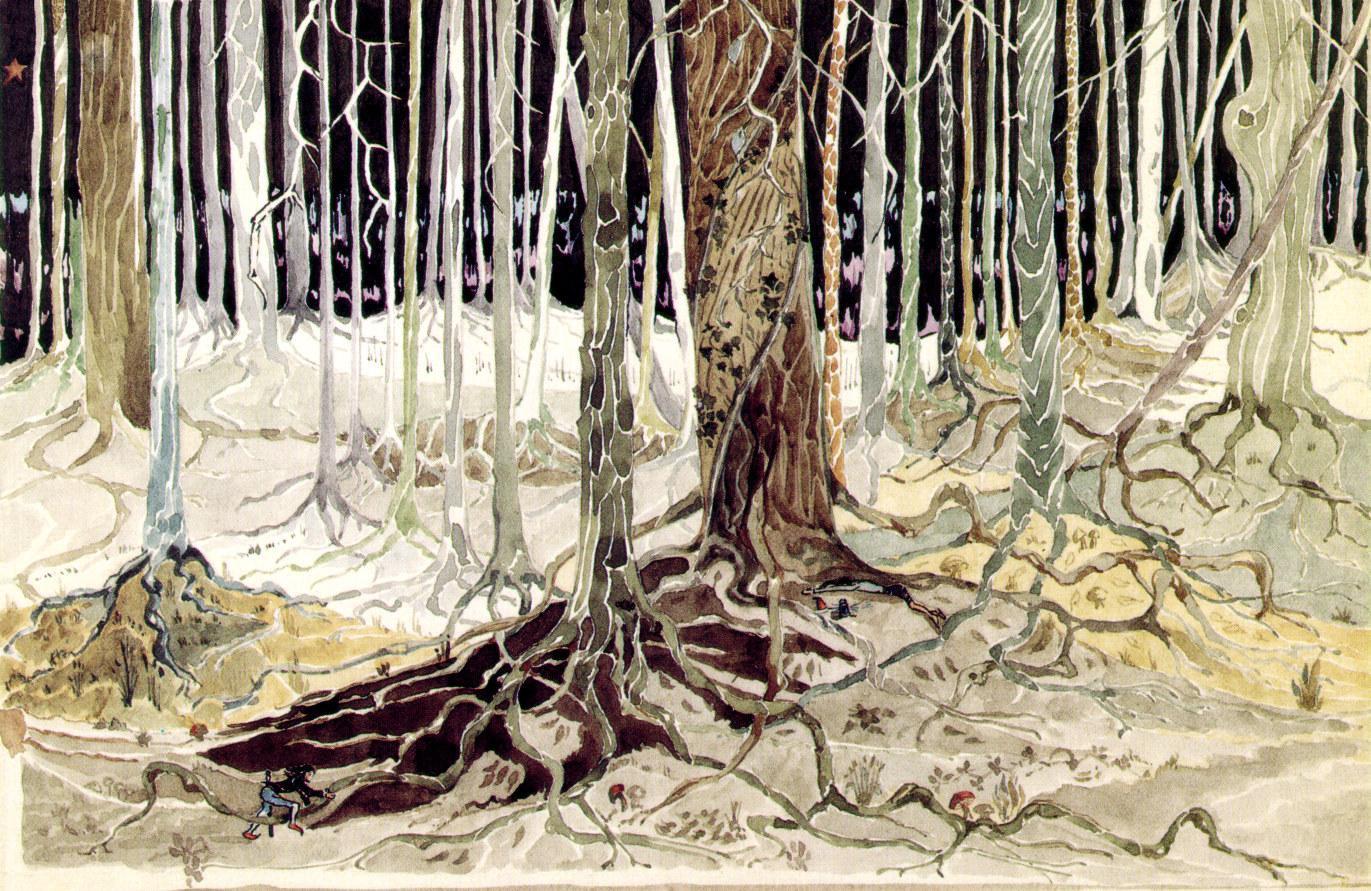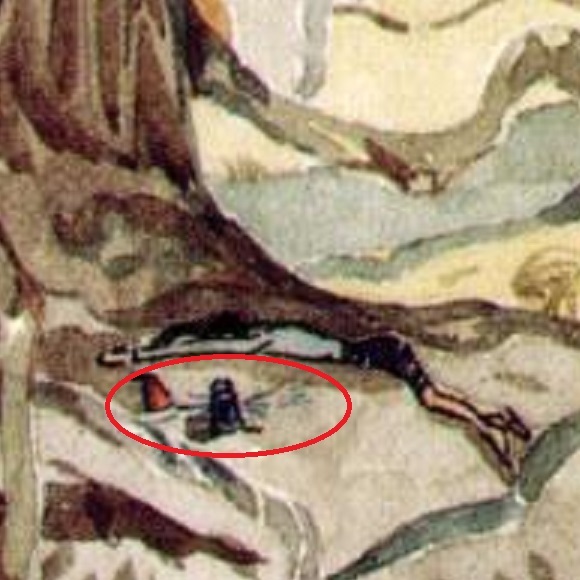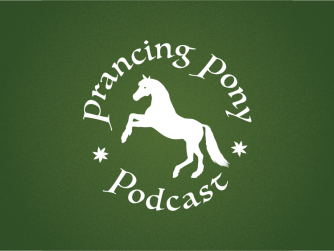In the first of two episodes on Tuor and the Fall of Gondolin, we go beyond The Silmarillion into Tolkien’s Unfinished Tales to tell the story the way it was meant to be told. The son of Huor and Rían survives capture, thraldom, and life as an outlaw to follow the footstep of doom, and soon finds himself face-to-face with Ulmo, the Lord of Waters. Tuor is offered a quest to find Gondolin and bring a message of warning from Ulmo, in fulfillment of a plan laid centuries ago. Also, answers to a listener question about Elven sleeping habits reveal gaps in both Shawn’s research… and his knowledge of Star Trek.
Below is an image of the painting Taur-na-Fuin by J.R.R. Tolkien, depicting Beleg’s finding of Gwindor:
Gwindor can be seen lying prone near the roots of the large tree at center, with a red hat and a Fëanorian lamp on the ground beside him: 
Artwork above is copyright of The Tolkien Estate Limited or The Tolkien Trust.
For an image of Tuor, Gelmir, and Arminas by Ted Nasmith depicting Gelmir’s Fëanorian lamp, visit the artist’s home page here: http://www.tednasmith.com/tolkien/tuor-gelmir-and-arminas/
Recommended Reading:



I listened to this a while ago but remember you didn’t mention a passage I thought was relevant regarding the Elvish sleep question. In “Of the Ruin of Beleriand and the Fall of Fingolfin”:
“There came a time of winter, when night was dark and without moon; and the wide plain of Ard-galen stretched dim beneath the cold stars, from the hill-forts of the Noldor to the feet of Thangorodrim. The watchfires burned low, and the guards were few; on the plain few were waking in the camps of the horsemen of Hithlum.”
Here it’s clearly stated that many of the Noldor were asleep before Morgoth began the Battle of Sudden Flame. The horsemen could have been Edain, however later in the same chapter it’s stated that there were Elven horse-archers which leads me to conclude that “few were waking” applies to Noldor, the previous descriptions indicate a state of drowsy inattentiveness as well.
That’s an excellent point, Patrick! Yes, that does appear to say that there were Noldor asleep before the Battle of Sudden Flame broke out. Very interesting; were they in the kind of half-awake dream state that we see Legolas in, and is that enough to make them inattentive to their surroundings? If so, then how different is that from actual sleep?
Another great episode! The comparison between Túrin and Tuor reminds me of those old Goofus and Gallant illustrations and it made me laugh.
Geese are swans that were corrupted by Morgoth.
Womp.
Hi guys, long time listener, first time ‘caller.’
I admire and respect the tremendous work you do, and I enjoy every moment of The Prancing Pony Podcast. The only disappointment is your reluctance to discuss The Book of Lost Tales in the HoME (even though you frequently refer to Morgoth’s Ring and to War of the Jewels). You too readily dismiss the Book of Lost Tales as early drafts, concluding that only the published Silmarillion is “canon.’ They should be viewed as alternative renderings of the same myths. Consider that we don’t have a single, canonical version of the various legends surrounding Hercules or King Arthur, Compare the Gospel According to Matthew to that of Luke, or Genesis Chapter 1 to Chapter 2! The Lost Tales are an earlier, more primitive retelling of the same legend, but a no less valid one.
Treating the published Silmarillion as the only reliable account is inappropriate for two reasons:
1.) None of this works were in final, finished form when the Professor passed away. Had he lived another 25 years, there would no doubt have been further revisions and elaborations. Elements that were left out of later drafts might have been restored. Note how the “Sketch of the Mythology” leaves out numerous elements from the Lost Tales that were restored in the “Quenta,” (see The Shaping of Middle Earth). The published Silmarillion is a compendium, and in some chapters only a synopsis, of the underlying legend. We should not perceive that the earlier versions are less canonical.
2.) The published Silmarillion preceded the HoME in publication date, but that alone doesn’t make it more valid. Christopher Tolkien decided to gather what seemed to him to be the latest versions of the legends and attempt to create a novel from them. Subsequently, and to the eternal delight of all Tolkien’s fans, the Book of Lost Tales was published, followed by additional HoME volumes over the years. There is no justification for believing that a volume published in t1977 is more canonical that a volume published in 1986.
Why am I sharing this grievance in this episode? Other than the Tale of the Sun and Moon, the Fall of Gondolin is one of the best opportunities to spend an episode discussing the Lost Tale. The version in the published Silmarillion is a disappointment when compared to what it could have been. You acknowledge this by spending an entire podcast on the version in Unfinished Tales. How we all wish that the Professor had finished that version, instead of leaving us with the abbreviated version in the Silmarillion. But we have some idea of how that completed version would have appeared because we have the Fall of Gondolin from Book of Lost Tales Volume 2. Although inconsistent in some ways with the later versions (Ecthelion and Tuor killing multiple Balrogs, etc.), the story is truly Tolkien at his best. And since you spent 3 episodes on Beren and Luthien and on Turin Turambar, a third episode on the Fall of Gondolin would have kept the precedent.
As a final thought, you shouldn’t apologize to your audience for the length of the episodes! I suspect most of us don’t listen to them in a single sitting. I listen while working in the yard, so I don’t care if the episode is longer or shorter than others, I just pause and resume later. What matters to us is that the material is interesting, thought-provoking, and thorough. I’d always prefer to hear more from you guys!
Thank you for listening and for the kind words!
As for your criticism about our treatment of The Book of Lost Tales: you make some fair points. We drew a line in the sand early on that we would only treat the “finished” works as canon (including The Silmarillion as the only version of those stories presented as finished, though of course that’s fudging a bit), and for the last six years have gradually been breaking that rule. To be fair, the BoLT is much more different from The Silmarillion than, say, the Lay of Leithian… but yes, we could have done more to bring those lost tales in as alternate versions.
The good news is that we have already made a plan to revisit The Silmarillion again in a future season, because there are a few things we would like to do differently — including this. So when we do we that (probably in our last season) we will be bringing in the alternate versions as much as possible! So stay tuned and I think we’ll make it right.